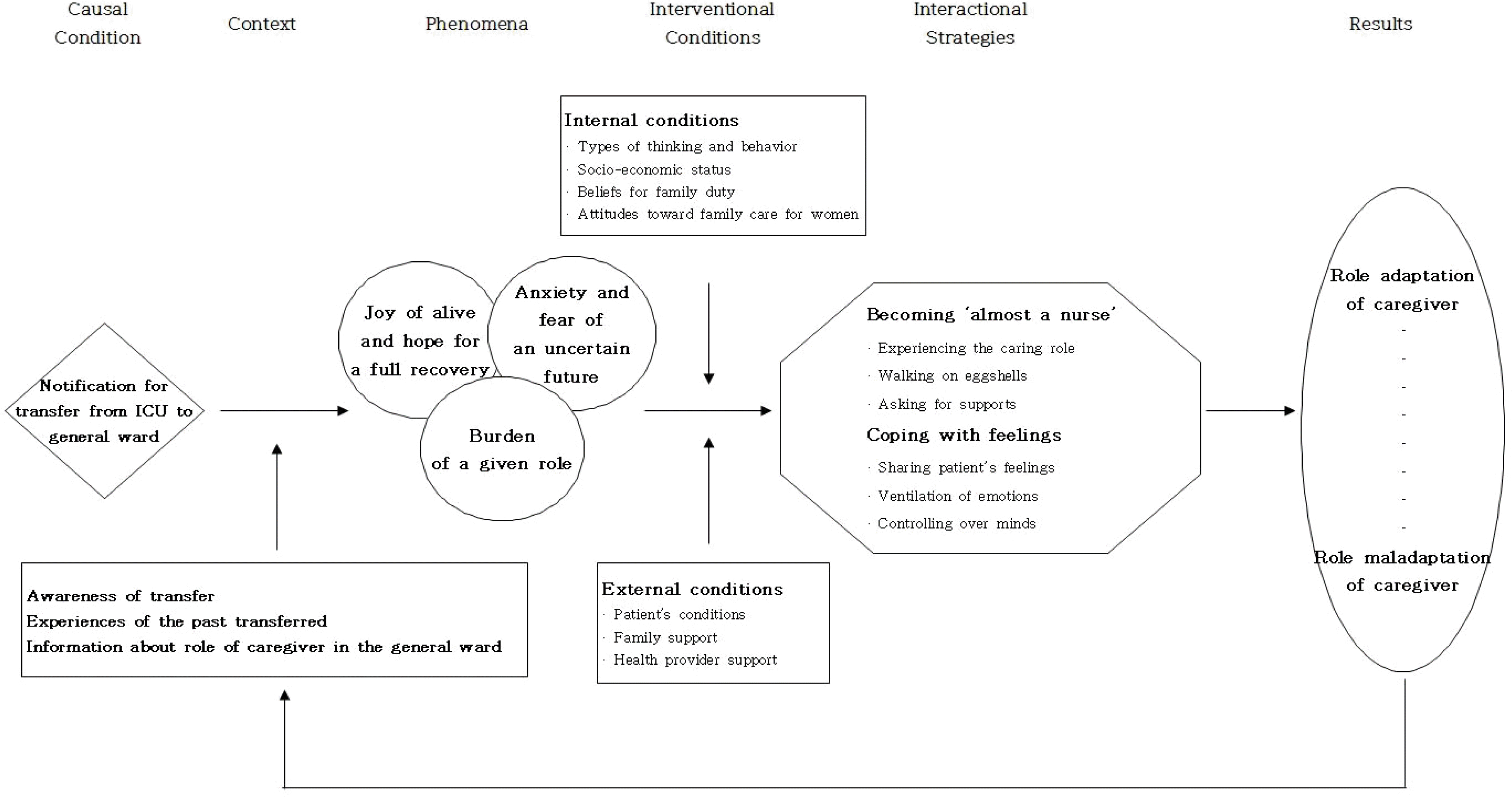Abstract
Purpose
The purpose of this study was to explore and identify the role adaptation processes of family caregivers with patients transferred from intensive care unit to general ward.
Methods
Using a grounded theory methodology, in-depth individual interviews were conducted. Data were collected from 11 participants. The participants were asked about their experiences of role adaptation considering situational contexts and interactional strategies. Transcribed data and field notes were analyzed using constant comparative analysis.
Results
The core category was ‘becoming almost a nurse with hope and fear.’ The identified phenomena by the participants were the joy of being alive, having hope for a full recovery, anxiety and fear of uncertain future, feeling burdensome on a given role. The results included both role adaptation and maladaptation of caregivers.
Conclusion
The role adaptation processes of family caregiver with patients transferred from intensive care unit to general ward can be explained as becoming almost a nurse with hope and fear. The findings of the study provided fundamental information for developing programs to support the given family caregivers for successful role adaptation.
REFERENCES
1.Relman AS. Intensive-care units: who needs them? The New England journal of medicine. 1980. 302(17):965.

2.Kohlenberger C., Sprung C., Danis M., Armstrong C., Baily M., Chalfin D, et al. Consensus statement on the triage of critically ill patients. Journal of the American Medical Association. 1994. 271(15):1200–3.
3.Chick N., Meleis AI. Transitions: a nursing concern. School of Nursing Departmental Papers. 1986. 9.
4.Chaboyer W., James H., Kendall M. Transitional care after the intensive care unit: current trends and future directions. Critical Care Nurse. 2005. 25(3):16–28.
5.Cullinane JP., Plowright CI. Patients' and relatives' experiences of transfer from intensive care unit to wards. Nursing in Critical Care. 2013. 18(6):289–96. http://dx.doi.org/10.1111/nicc.12047.

6.Chaboyer W., Kendall E., Kendall M., Foster M. Transfer out of intensive care: a qualitative exploration of patient and family perceptions. Australian Critical Care. 2005. 18(4):138–45.

7.Leith BA. Patients' and family members' perceptions of transfer from intensive care. Heart & Lung: The Journal of Acute and Critical Care. 1999. 28(3):210–8.

8.Bouvé LR., Rozmus CL., Giordano P. Preparing parents for their child's transfer from the PICU to the pediatric floor. Applied Nursing Research. 1999. 12(3):114–20.

9.Van Waning NR., Kleiber C., Freyenberger B. Development and implementation of a protocol for transfers out of the pediatric intensive care unit. Critical Care Nurse. 2005. 25(3):50–5.

10.Chaboyer W., Thalib L., Alcorn K., Foster M. The effect of an ICU liaison nurse on patients and family's anxiety prior to transfer to the ward: an intervention study. Intensive and Critical Care Nursing. 2007. 23(6):362–9.

11.Son YJ. Development and effects. Journal of Korean Clinical Nursing Research. 2009. 15(3):143–55.
12.Kim KH., Hong JS. A comparative study on attitudes toward family in Korea and Japan. Family and Culture. 2013. 25(3):186–213.
13.Corbin J., Strauss A. Basics of qualitative research: techniques and procedures for developing grounded theory. 3rd ed.London, UK: Sage Publications;2008. p. 1–400.
14.Sandelowski M. The problem of rigor in qualitative research. Advances n Nursing Science. 1986. 8:27–37.

15.Kim CM., Choi SB. The coping process of family caregivers for demented elderly at home and new diretion for welfare services. The Korean Journal of Regional Innovation. 2005. 1(1):97–151.
16.Son YJ., Seo YO., Hong SK. Experiences on transfer of critically ill patients from intensive care units to general wards. The Korean Journal of Fundamentals of Nursing. 2009. 16(1):92–102.
17.McCubbin MA., McCubbin HI. Families coing with illness: the resiliency model of family stress, adjustment and adaptation. Danielson CB, Hamel-Bissell B, Winstead-Fry P, editors. Families, health & illness perspectives on coping and intervention. Madison, WI: Mosby;1993. p. 1–340.
18.Meleis AI., Sawyer LM., Im E-O., Messias DKH., Schumacher K. Experiencing transitions: an emerging middle-range theory. Advances in Nursing Science. 2000. 23(1):12–28.

19.Choi MH. Caring experience of mothers with IDDM children. Journal of Korean Academy of Nursing. 1998. 28(1):81–92.

20.Davies S. Meleis's theory of nursing transitions and relatives'experiences of nursing home entry. Journal of Advanced Nursing. 2005. 52(6):658–71.
21.Streater C., Golledge J., Sutherland H., Easton J., MacDonald R., McNamara R, et al. The relocation experiences of relatives leaving a neurosciences critical care unit: a phenomenological study. Nursing in Critical Care. 2001. 6(4):163–70.
Figure 1.
Role adaptation processes of patient's family caregiver transferred from intensive care unit to a general ward.

Table 1.
Dimensions, Categories and Sub-categories of the Experiences of Role Adaptation Processes of the Participants




 PDF
PDF ePub
ePub Citation
Citation Print
Print


 XML Download
XML Download